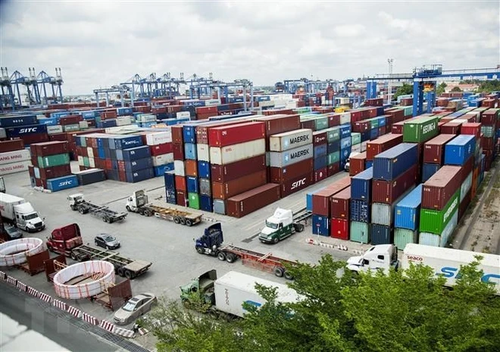 Vietnam earned 100 billion USD from exports to the 500-million-customer CPTPP market in 2023. (Photo: VNA) Vietnam earned 100 billion USD from exports to the 500-million-customer CPTPP market in 2023. (Photo: VNA) |
In the past five years the CPTPP has boosted trade between Vietnam and countries in the Asia-Pacific region, including countries without FTAs like Canada, Mexico, and Peru, and demanding markets like Japan, Australia, and New Zealand.
Last year Vietnam earned 100 billion USD from exports to the 500-million-customer CPTPP market, a market that always brings a trade surplus for Vietnam.
Nguyen Thi Thu Trang, Director of the World Trade Organization and Integration Center of the Vietnam Chamber of Commerce and Industry, said that seven of 10 CPTPP partners are countries with which Vietnam has one or more free trade agreements.
“The CPTPP is the first trade agreement that gives Vietnam an all-out penetration into the American market. In the past we signed an FTA with Chile, but that was a small-scale deal. Thanks to the CPTPP, Vietnam has access to Peru and Chile in South America and Canada and Mexico in North America. Those are potential markets for Vietnam,” said Trang.
Tran Thanh Hai, Deputy Director of the Import-Export Department of the Ministry of Industry and Trade, said Vietnamese businesses are getting to know how to take advantage of opportunities brought by new-generation trade agreements like CPTPP.
“CPTPP members have seen extremely impressive growth recently,” Hai commented, adding, “Unlike the European Union, Vietnam’s traditional export market, the CPTPP region, especially Canada, Mexico, and Peru, is relatively new where Vietnam’s exports have been modest over the years. But after the CPTPP was signed, Vietnam's exports there have increased dramatically."
Under the CPTPP, signatories commit to completely eliminating at least 97% of import tax lines on goods originating in Vietnam.
 Tran Thanh Hai, Deputy Director of the Import-Export Department of the Ministry of Industry and Trade. (Photo: MOIT) Tran Thanh Hai, Deputy Director of the Import-Export Department of the Ministry of Industry and Trade. (Photo: MOIT)
|
According to Le Duy Binh, Managing Director of Economica Vietnam, Vietnam's exports to the CPTPP market with added value and high technology remain low and Vietnamese businesses’ penetration rate is low too. The biggest barrier for Vietnamese exporters is meeting the strict origin of goods requirements.
He said domestic businesses have different degrees of understanding of the origin of goods and CPTPP itself has regulations on the origin of goods, under which businesses must have appropriate processes for organizing production, purchasing input materials, farming, or fishing.
“This requires Vietnamese producers and businesses to gather all required documents to prove the point of origin. I think this is very difficult for many businesses," Binh noted.
As of the end of 2022, the CPTPP has come into force for most participating members. Last July the UK officially became a new member of the deal and many other economies have expressed an interest in joining.
This fact creates both opportunities and challenges, according to Luong Hoang Thai, Director of the Multilateral Trade Policy Department of the Ministry of Industry and Trade.
“The CPTPP is drawing the attention of many countries who have sent letters expressing their desire to join the agreement, including China and ASEAN countries like the Philippines and Thailand,” said Thai, adding, “This means the CPTPP will become more influential than when Vietnam signed and ratified its participation. But it will create greater competition among signatories."
To improve business competitiveness within the CPTPP, Thai urged Vietnamese companies to increase their product value by conforming to the criteria, tastes, and requirements of import markets, and developing green, environment-friendly products.